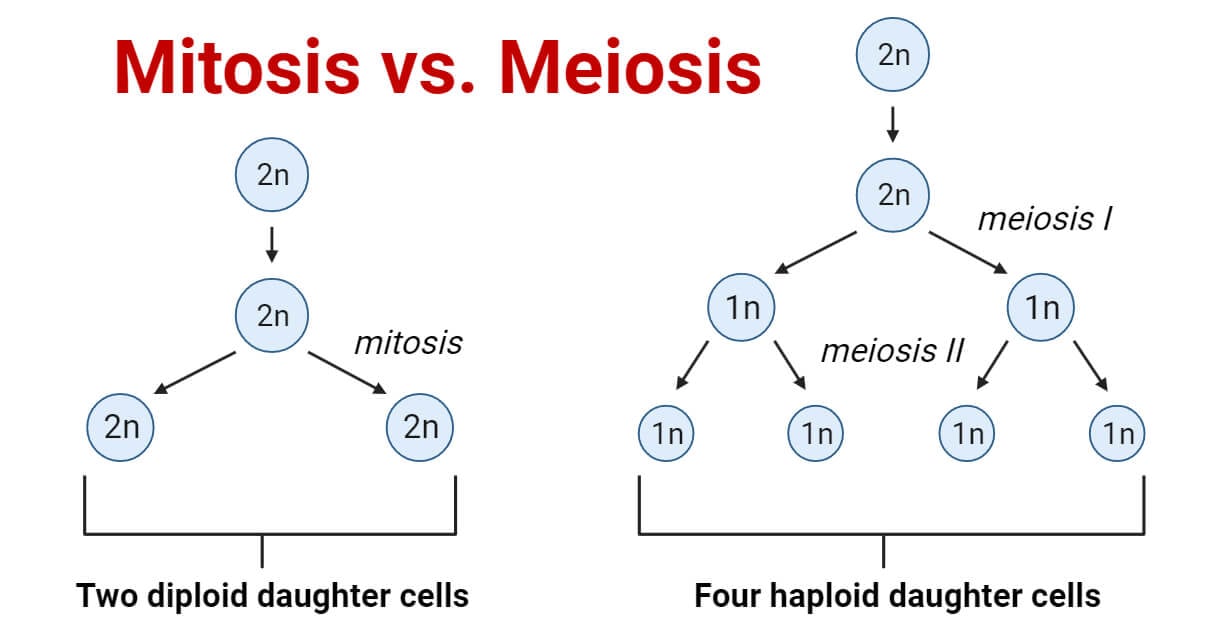
Interesting Science Videos
Here are some of the differences between Mitosis and Meiosis
S.N. | Character | Mitosis | Meiosis |
| 1. | Alternate Name | Equational Division | Reduction Division |
| 2. | Discovered by | Walther Flemming | Oscar Hertwig |
| 3. | Type of Cells Involved | Somatic cells. | Sex cells/germ cells or gametes. |
| 4. | Type of Reproduction | Asexual division | Sexual division |
| 5. | Mother Cells | Can be either haploid or diploid | Always diploid |
| 6. | Number of Divisions | Mitosis involves only one cell division. | Involves two successive divisions. |
| 7. | Duration | Comparatively shorter. | Longer. |
| 8. | Number of daughter cells | Two | Four |
| 9. | Result into | Diploid (2n) offspring | Haploid (n) offspring |
| 10. | Reduction in Chromosome Number | No reduction in chromosome number. | Results in the reduction in chromosome number by half. |
| 11. | Genetical Identity | Daughter cells are genetically the same. | Daughter cells are genetically different due to recombination. |
| 12. | Recombination or Crossing over | No recombination or crossing over occurs. | Crossing over occurs. |
| 13. | Leads to formation of | Everything other than sex cells. | Sex cells only: female egg cells or male sperm cells. |
| 14. | Steps Involved | Prophase, Metaphase, Anaphase, Telophase. | (Meiosis 1) Prophase I, Metaphase I, Anaphase I, Telophase I; (Meiosis 2) Prophase II, Metaphase II, Anaphase II and Telophase II. |
| 15. | Interphase | Interphase occurs prior to each division. | Interphase precedes in only Meiosis I. It does not occur prior to Meiosis II. |
| 16. | DNA replication during Interphase | Takes place during Interphase. | Takes place during Interphase I but not during Interphase II. |
| 17. | DNA replication | Occurs once for one cell division. | Occurs once for two cell divisions. |
| 18. | Steps and Length of Prophase | A cell spends less time in prophase of mitosis than a cell in prophase I of meiosis.
No sub stages occur in mitosis. | Prophase I consist of five stages and lasts longer than prophase of mitosis. The five stages of meiotic prophase I are leptotene, zygotene, pachytene, diplotene, and diakinesis. |
| 19. | Prophase | Simple | Complicated |
| 20. | Synapsis | No synapsis | Synapsis of homologous chromosomes takes place during prophase. |
| 21. | Tetrad Formation | Tetrad formation does not occur. | A tetrad consisting of four chromatids (two sets of sister chromatids) lined up closely together is formed. |
| 22. | Centromere | Each chromosome consists of two chromatids united by a centromere. | The two homologous chromosomes form bivalents or tetrads. Each bivalents has four chromatids and two centromeres. |
| 23. | Metaphase | Sister chromatids align at the metaphase plate (a plane that is equally distant from the two cell poles). | Tetrads (homologous chromosome pairs) align at the metaphase plate in metaphase I. |
| 24. | Chromosome Alignment in Metaphase | In the metaphase plate, all the centromeres line up in same plate. | In metaphase I, the centromeres are lined up in two planes which are parallel to one another. |
| 25. | Chiasmata | Absent | Observed during prophase I and metaphase I. |
| 26. | Anaphase | Sister chromatids separate and begin migrating centromere first toward opposite poles of the cell. A separated sister chromatid becomes known as daughter chromosome and is considered a full chromosome. | During anaphase I, (double stranded) chromosomes are separated toward each cellular pole. Sister chromatids do not separate in anaphase I. On the other hand, (single stranded) chromosomes are the ones being segregated during anaphase II. |
| 27. | Centromeres Split | The centromeres split during anaphase. | The centromeres do not separate during anaphase I, but during anaphase II. |
| 28. | Spindle Fibres | Disappear completely in telophase. | Do not disappear completely in telophase I. |
| 29. | Nucleoli | Reappear at telophase. | Do not reappear at telophase I. |
| 30. | Karyokinesis | Occurs in Interphase. | Occurs in Interphase I. |
| 31. | Cytokinesis (division of the cytoplasm) | Occurs at the end of telophase. | Cytokinesis happens at the end of telophase I and telophase II. |
| 32. | Functions | Facilitate growth, repair, and replacement. To produce more cells especially during the early stages of development. To regenerate damaged and lost cells. Mitosis also occurs in prokaryotes as an essential form of asexual reproduction. | Takes part in the formation of gametes. To maintain the chromosome number of the offspring. For maintenance of genetic diversity on which the process of natural selection acts upon. |
References
- Verma, P., & Agarwal, V. (2005). Cell biology, genetics, molecular biology, evolution and ecology. New Delhi: S.Chand.
- https://microbiologyinfo.com/differences-between-mitosis-and-meiosis/
- https://www.bioexplorer.net/differences-between-mitosis-and-meiosis.html/
- https://www.thoughtco.com/differences-between-mitosis-and-meiosis-373390
- https://www.biologyexams4u.com/2012/09/difference-between-mitosis-and-meiosis.html#.W1bbDDozbIU
